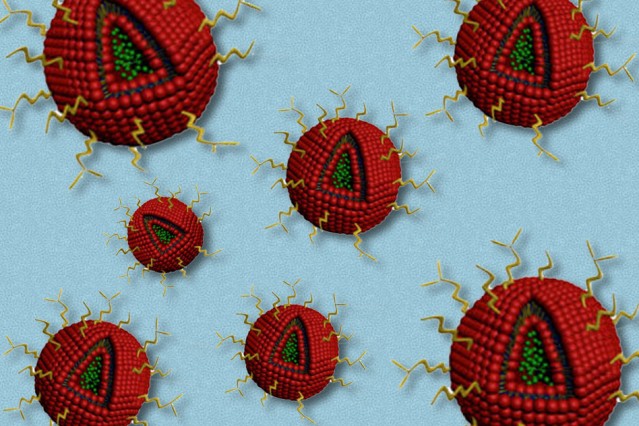Glioblastoma multiforme is one of the hardest cancers to treat. Affecting the tissues between nerve cells in the brain, it is aggressive and has a very high mortality rate. Very few drugs are available that are effective against it, and those few effective drugs tend to have unpleasant side effects.

The nanoparticles contain one drug in their outer shell and another in their hollow core. A biodegradable polymer coating masks them from the immune system. Image: Stephen Morton
Engineers at MIT have now developed a method of smuggling effective drugs into brain tissues to attack glioblastoma cells in two ways. Packed into particles that can cross the blood-brain barrier – a structure that prevents large molecules from reaching brain cells which makes treating brain diseases particularly tricky – are two drugs: one which damages DNA inside the tumour cells, and another which blocks the tumour cells’ own repair systems.
The MIT team includes Prof Paula Hammond, a member of MIT’s Koch Institute for integrative Cancer research, and Scott Floyd, an expert in radiation oncology from Duke University School of Medicine in North Carolina. The research uses nanoparticles based on a design pioneered by Hammond: these are liposomes, hollow spherical shells whose walls are composed of long-chain fatty molecules. These have a significant advantage – the hollow core can be filled with one drug, while the walls can be loaded with another.
To get the particles across the blood-brain barrier, the team coated the outside the liposome with a protein called transferrin, which normally is a component of blood plasma and can help carry iron from the gut. This not only carried the particles through the barrier, but also binds to proteins found on the surface of tumour cells, allowing the loaded particles to accumulate at the tumour site while avoiding healthy cells. This means that the system can be used to deliver higher doses of chemotherapy agents now will not be possible to transfused directly into the bloodstream because that could cause highly damaging side-effects. The drug loaded into the particle cores was temozolomide, which is known to cause bruising, nausea and weakness.
Temozolomide damages tumour cell DNA, as Floyd and Michael Yaffe, another Koch Institute researcher, have previously established. The outer shell contains an experimental drug called a bromodomain inhibitor, which stops the cells from repairing DNA damage. In tests on mice, the team established that the shell drug acts first as the fatty molecules disperse, then around 24 hours later the temozolomide is released, attacking the cells while the defences are down. In the trials, the animals which received the nano particle treatment survived twice as long as mice that received other treatments. They also suffered much less damage to blood cells and other tissues normally harmed by temozolomide.
As an extra safeguard, the particles were coated with polyethylene glycol, which masks them from the body’s immune system. "Our goal was to have something that could be easily translatable, by using simple, already approved synthetic components in the liposome," said Fred Lam, another Koch Institute researcher and lead author on the team’s research paper which appears in Nature Communications. "This was really a proof-of-concept study [showing] that we can deliver novel combination therapies using a targeted nanoparticle system across the blood-brain barrier."
When the team progresses to clinical trials in humans, it will need to use a different bromodomain inhibitor because the one used initially has too short a half life. However, others are now in clinical trials.
Floyd is particularly excited about these results. "Because there's such a short list of drugs that we can use in brain tumours, a vehicle that would allow us to use some of the more common chemotherapy regimens in brain tumours would be a real game-changer," he said. "Maybe we could find efficacy for more standard chemotherapies if we can just get them to the right place by working around the blood-brain barrier with a tool like this."




April 1886: the Brunkebergs tunnel
First ever example of a ground source heat pump?